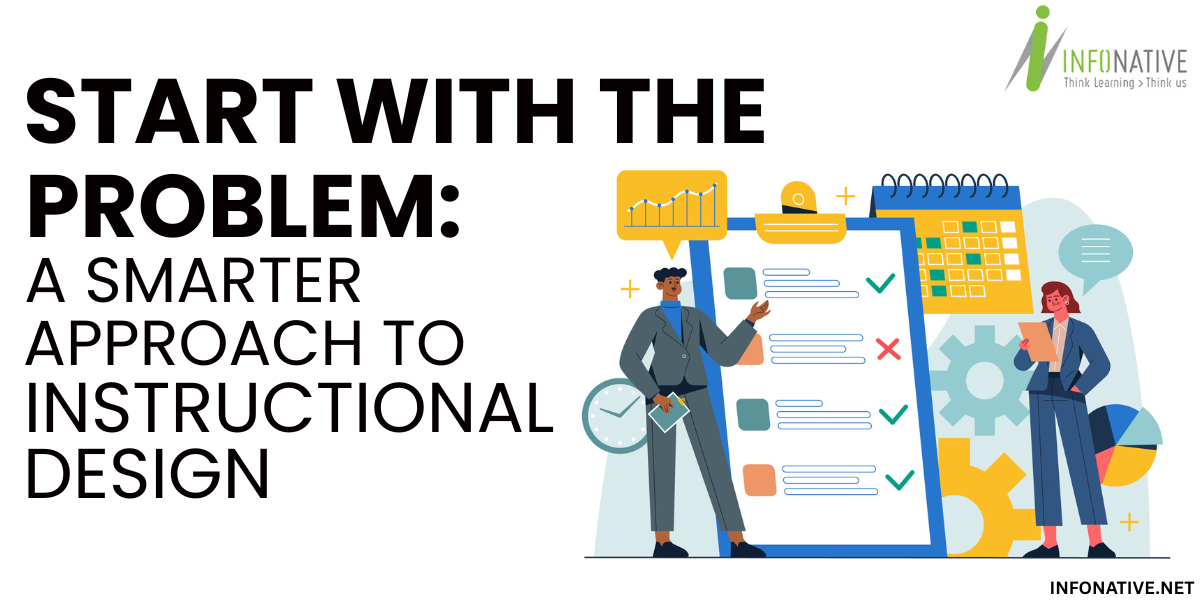In a world overloaded with content, the smartest way forward isn’t more information—it’s deeper intention. Enter the problem-first approach, a method that flips the script on traditional training models.
Instead of asking “What do we want to teach?” we ask, “What problem are we solving?”
This shift doesn’t just sound strategic—it transforms how learners engage, how outcomes are measured, and how organizations unlock meaningful change.
Let’s explore how this mindset overhaul leads to actionable, engaging, and relevant learning journeys that actually sticks.
Why Instructional Design Needs a Reboot
For decades, instructional design frameworks have focused on outlining learning objectives, sequencing content, and selecting delivery formats. While these elements are critical, they rarely answer the learner’s most pressing question: “Why should I care?”
Employees and learners today face overwhelming content, limited time, and high expectations. If your content doesn't solve an urgent problem they face in their role, it risks being ignored, skimmed, or forgotten. Instructional design needs to move from content-first to context-first, where the context is defined by real-world challenges.
Problem-First Design: The Core Philosophy
At its heart, the problem-first approach flips the traditional instructional model. Instead of starting with what learners need to know, you start with what they need to solve. This means identifying the specific challenges, pain points, or performance gaps your audience is facing—and then designing learning experiences that address those directly.
It’s less about dumping information and more about facilitating transformation.
Here’s how that shift shows up:
• Courses framed around solving business problems rather than exploring generic topics.
• Lessons guided by real-world scenarios, not theoretical outlines.
• Learners applying concepts immediately, not later in an abstract assessment.
Why It Works: Psychological Triggers and Engagement
From a cognitive standpoint, problem-based learning aligns perfectly with adult learning principles (andragogy). Adults are internally motivated, goal-oriented, and prefer learning that is immediately applicable.
Starting with a problem activates curiosity and urgency—learners are more likely to pay attention, engage deeply, and retain information when they’re navigating a challenge they recognize. It's the difference between watching a tutorial, versus desperately searching for a solution right now.
This urgency drives what's known as "situational interest"—a spontaneous, short-term surge in motivation triggered by relevant content. When your instructional design leverages this psychological edge, learners don’t just show up. They stay.
Implementing the Problem-First Approach: Practical Steps
Shifting your instructional design workflow doesn’t require a full system overhaul. It starts with asking different questions at the beginning of the design phase:
1. What’s the core problem learners are facing? Interview stakeholders, review performance data, and look beyond surface-level behaviors to diagnose real skill gaps.
2. How does this problem show up in their work? Understand how it affects their outcomes, efficiency, or decisions—this context will shape your scenarios and learning paths.
3. What’s blocking resolution today? Are there missing skills, knowledge gaps, process inefficiencies, or mindset barriers? Learning should dismantle these obstacles.
4. How will solving this problem look and feel? Paint a clear picture of success: what learners will be able to do and how their performance will improve.
Then, translate these insights into learning objectives that align with outcomes—not just content coverage.
Design Tactics That Reinforce the Approach
Once the problem is central, your design tactics can mirror it through:
• Scenario-Based Learning: Frame content around workplace challenges learners recognize.
• Problem-Solving Activities: Replace static quizzes with decision-making tasks or simulations.
• Reflection Prompts: Encourage learners to tie their experience back to the problem, reinforcing relevance.
Business Impact: Why Stakeholders Should Care
For organizations, problem-first instructional design translates into faster time-to-impact. Instead of waiting weeks or months to see improvement post-training, results show up sooner because learning is targeted and practical.
Consider these direct benefits:
• Reduced learning fatigue as learners engage with less but more relevant content.
• Improved ROI on training initiatives due to clearer performance alignment.
• Accelerated change adoption when new initiatives are taught through problem-solving rather than policy briefs.
• Stronger stakeholder trust as business leaders see training connected to strategic challenges.
When your instructional content solves real problems, it becomes indispensable.
The Role of Data and Iteration
The problem-first model thrives on feedback loops. Post-training surveys, performance metrics, and learner interactions offer insights into what's working—and what's not. Instructional designers can adjust content and delivery formats to stay tightly aligned with evolving problems.
Use platforms with built-in analytics to measure not just completion rates, but learning outcomes and workplace impact. Especially in fields like HR, marketing, and operations, data-backed learning reinforces strategy.
Real-World Example: A People Analytics Training Makeover
Let’s take a concrete example. Imagine an HR team struggling with high attrition and disengagement.
A traditional training might outline theories of employee engagement or retention tactics.
A problem-first training reframes it: “You’re seeing 20% turnover in your top talent pool. What’s causing it, and what data will help you intervene?”
The course then walks learners through analyzing attrition metrics, identifying patterns, and taking strategic action. Engagement skyrockets, and learners emerge not just informed—but empowered.
This is the kind of impact Infonative’s People Analytics training program aims to deliver. It’s not about teaching HR professionals what attrition means. It’s about helping them solve it.
Conclusion
Instructional design is not just about delivering information—it’s about facilitating change. In a world overloaded with content, the smartest way to stand out is to start with the problem your learners are eager to solve.
By reframing your courses to be context-driven, scenario-based, and outcome-oriented, you can transform passive learning into active problem-solving. And when you do that, you’re not just teaching—you’re enabling.
Whether you're designing for HR, marketing, or any field demanding results, embrace the power of the problem-first approach. Your learners and your business outcomes will thank you!




